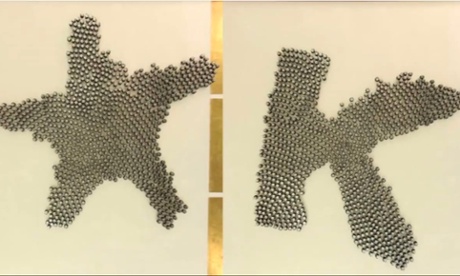
Swarms of small robots in their thousands that collectively complete complex tasks are now possible – and could be the future of robotics, according to researchers.
The Kilobots are a team of 1,024 simple robots that operate as a collective, much like the Borg in Star Trek or termites in a termite mound, and been shown to demonstrate the ability to swarm together to form complex shapes like the letter “K”, or a starfish.
“The beauty of biological systems is that they are elegantly simple — and yet, in large numbers, accomplish the seemingly impossible,” said Prof Radhika Nagpal from the Harvard school of engineering and applied sciences. “At some level, you no longer even see the individuals; you just see the collective as an entity to itself.”
The kilobits demonstrate how simple machines performing simple behaviours can create complexity en masse. The robots, which are a couple of centimetres in diameter and vibrate tiny legs to move, are given a simple instruction like “make the letter K” and then left to get on with it without further human interaction, communicating with each other via infrared.
Four robots move to the centre of the shape, while the rest follow the edge of the group and use their relative positions to take turns to fill in the shape. If a traffic jam forms, nearby robots sense the issue and co-operate to fix it as well as other errors.
‘Enormous numbers of co-operating entities’
This is the first time that more than 100 robots have been demonstrated cooperating in a collective, with 1,024 being an important step towards mass swarms of tiny robots able to operate a bit like the simple biological cells that club together to form complex organisms, animals and humans.
“Biological collectives involve enormous numbers of cooperating entities – whether you think of cells or insects or animals – that together accomplish a single task that is a magnitude beyond the scale of any individual,” said Michael Rubenstein, lead author on the study published in Science.
The technology is being heralded as an important milestone in the development of collective artificial intelligence, and could lead to the development of complex machines that build themselves out of swarms of tiny, simple robots.
“We can simulate the behavior of large swarms of robots, but a simulation can only go so far,” said Nagpal. “The real-world dynamics — the physical interactions and variability — make a difference, and having the Kilobots to test the algorithm on real robots has helped us better understand how to recognise and prevent the failures that occur at these large scales.”
For now, these small robots simply make shaped by sliding across a table top, but the next stage is to refine the intelligence and develop smaller robots capable of the same tasks, eventually aiming for the nano scale.
• Self-assembling origami robot is world’s first Transformer

